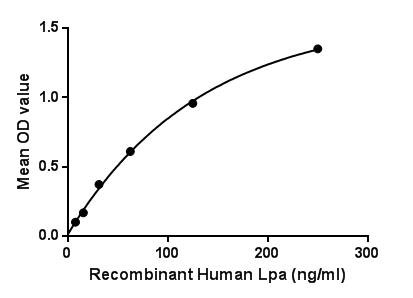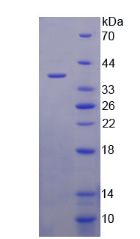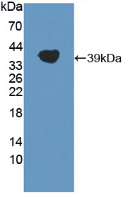Active Lipoprotein, a (Lpa) 

Lp(a); AK38; APOA; LP; Sinking Pre-β-Lipoprotein
- UOM
- FOB US$ 228.00 US$ 570.00 US$ 1,140.00 US$ 3,420.00 US$ 8,550.00
- Quantity
Overview
Properties
- Product No.APA842Hu01
- Organism SpeciesHomo sapiens (Human) Same name, Different species.
- ApplicationsCell culture; Activity Assays.
Research use only - DownloadInstruction Manual
- CategoryMetabolic pathwayCardiovascular biologyHepatology
- Buffer FormulationPBS, pH7.4, containing 0.01% SKL, 5% Trehalose.
- Traits Freeze-dried powder, Purity > 95%
- Isoelectric Point8.4
Sign into your account
Share a new citation as an author
Upload your experimental result
Review

Contact us
Please fill in the blank.
Activity test

Lipoprotein, a (Lpa) is a lipoprotein subclass. Lpa is assembled at the hepatocyte cell membrane surface, while other scenarios exist with regard to the location of assembly. It mainly exists in plasma. Lpa contributes to the process of atherogenesis. It also may enhance coagulation by inhibiting the function of tissue factor pathway inhibitor. Lpa carries cholesterol and binds atherogenic proinflammatory oxidized phospholipids as a preferential carrier of oxidized phospholipids in human plasma, which attract inflammatory cells to vessel walls and leads to smooth muscle cell proliferation. Moreover, Lpa also is hypothesized to be involved in wound healing and tissue repair, interacting with components of the vascular wall and extra cellular matrix. Besides, Fibronectin (FN) has been identified as an interactor of Lpa, thus a binding ELISA assay was conducted to detect the interaction of recombinant human Lpa and recombinant human FN. Briefly, Lpa were diluted serially in PBS, with 0.01% BSA (pH 7.4). Duplicate samples of 100μL were then transferred to FN-coated microtiter wells and incubated for 2h at 37℃. Wells were washed with PBST and incubated for 1h with anti-Lpa pAb, then aspirated and washed 3 times. After incubation with HRP labelled secondary antibody, wells were aspirated and washed 3 times. With the addition of substrate solution, wells were incubated 15-25 minutes at 37℃. Finally, add 50µL stop solution to the wells and read at 450nm immediately. The binding activity of Lpa and FN was shown in Figure 1, and this effect was in a dose dependent manner.
Figure. The binding activity of Lpa with FN.
Usage
Reconstitute in 10mM PBS (pH7.4) to a concentration of 0.1-1.0 mg/mL. Do not vortex.
Storage
Avoid repeated freeze/thaw cycles. Store at 2-8°C for one month. Aliquot and store at -80°C for 12 months.
Stability
The thermal stability is described by the loss rate. The loss rate was determined by accelerated thermal degradation test, that is, incubate the protein at 37°C for 48h, and no obvious degradation and precipitation were observed. The loss rate is less than 5% within the expiration date under appropriate storage condition.
Increment services
-
 BCA Protein Quantification Kit
BCA Protein Quantification Kit
-
 Molecular Mass Marker for Protein
Molecular Mass Marker for Protein
-
 Monoclonal Antibody Customized Service
Monoclonal Antibody Customized Service
-
 Polyclonal Antibody Customized Service
Polyclonal Antibody Customized Service
-
 Protein Activity Test Experiment Service
Protein Activity Test Experiment Service
-
 Electrophoretic Mobility Shift Assay (EMSA) Experiment Service
Electrophoretic Mobility Shift Assay (EMSA) Experiment Service
-
 Buffer
Buffer
-
 Lentivirus Packaging Experiment Service
Lentivirus Packaging Experiment Service
-
 Adenovirus Packaging Experiment Service
Adenovirus Packaging Experiment Service
-
 Real Time PCR Experimental Service
Real Time PCR Experimental Service
-
 Spike RBD Protein (S-RBD)
Spike RBD Protein (S-RBD)
-
 Protein G
Protein G
-
 Protein A
Protein A
Citations
- Pigment Epithelium-Derived Factor (PEDF) Protects Osteoblastic Cell Line from Glucocorticoid-Induced Apoptosis via PEDF-RPubmed:27187377
- Danshen (Salvia miltiorrhiza) Compounds Improve the Biochemical Indices of the Patients with Coronary HeartDisease.Pubmed:27366196
- Lysophosphatidic Acid Regulates the Differentiation of Th2 Cells and Its Antagonist Suppresses Allergic Airway InflammationPubmed: 32846422
- Evaluation of serum ATX and LPA as potential diagnostic biomarkers in patients with pancreatic cancer33568105
- The binding of autotaxin to integrins mediates hyperhomocysteinemia-potentiated platelet activation and thrombosis34559203








